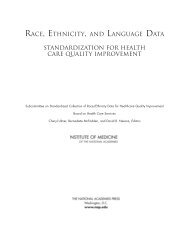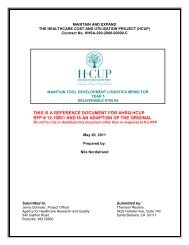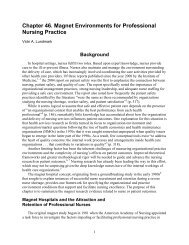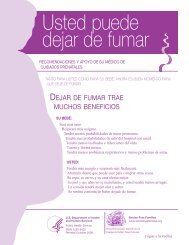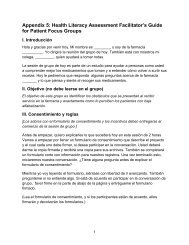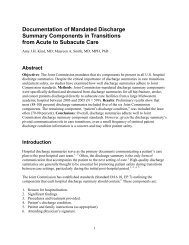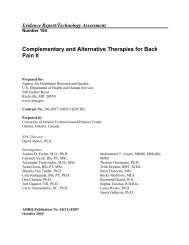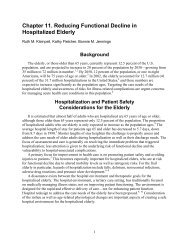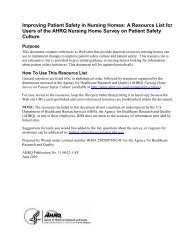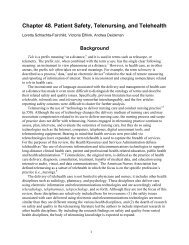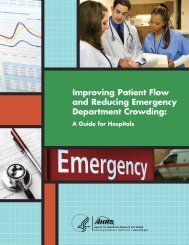Emergency Severity Index (ESI): A Triage Tool for Emergency ...
Emergency Severity Index (ESI): A Triage Tool for Emergency ...
Emergency Severity Index (ESI): A Triage Tool for Emergency ...
Create successful ePaper yourself
Turn your PDF publications into a flip-book with our unique Google optimized e-Paper software.
patients are admitted to intensive care units, while<br />
some die in the emergency department (Eitel, et al.,<br />
2003; Wuerz, 2001). A few <strong>ESI</strong> level-1 patients are<br />
discharged from the ED, if they have a reversible<br />
change in level of consciousness or vital functions<br />
such as with hypoglycemia, seizures, alcohol<br />
intoxication, or anaphylaxis.<br />
Examples of <strong>ESI</strong> level 1:<br />
• Cardiac arrest<br />
• Respiratory arrest<br />
• Severe respiratory distress<br />
• SpO2 < 90<br />
• Critically injured trauma patient who presents<br />
unresponsive<br />
• Overdose with a respiratory rate of 6<br />
• Severe respiratory distress with agonal or gaspingtype<br />
respirations<br />
• Severe bradycardia or tachycardia with signs of<br />
hypoperfusion<br />
• Hypotension with signs of hypoperfusion<br />
• Trauma patient who requires immediate<br />
crystalloid and colloid resuscitation<br />
• Chest pain, pale, diaphoretic, blood pressure<br />
70/palp.<br />
• Weak and dizzy, heart rate = 30<br />
• Anaphylactic shock<br />
• Baby that is flaccid<br />
• Unresponsive patient with a strong odor of<br />
alcohol<br />
• Hypoglycemia with a change in mental status<br />
• Intubated head bleed with unequal pupils<br />
• Child that fell out of a tree and is unresponsive<br />
to painful stimuli<br />
Decision Point B: Should the<br />
Patient Wait?<br />
Once the triage nurse has determined that the<br />
patient does not meet the criteria <strong>for</strong> <strong>ESI</strong> level 1, the<br />
triage nurse moves to decision point B (Figure 2-3)<br />
At decision point B, the nurse needs to decide<br />
whether this patient is a patient that should not<br />
wait to be seen. If the patient should not wait, the<br />
patient is triaged as <strong>ESI</strong> level 2. If the patient can<br />
11<br />
Chapter 2. Overview of the <strong>Emergency</strong> <strong>Severity</strong> <strong>Index</strong><br />
Figure 2-3. Decision Point B: Should the Patient<br />
Wait?<br />
wait, then the user moves to the next step in the<br />
algorithm.<br />
Three broad questions are used to determine<br />
whether the patient meets level-2 criteria:<br />
1. Is this a high-risk situation?<br />
2. Is the patient confused, lethargic or disoriented?<br />
3. Is the patient in severe pain or distress?<br />
The triage nurse obtains pertinent subjective and<br />
objective in<strong>for</strong>mation to quickly answer these<br />
questions. A brief introduction to <strong>ESI</strong> level-2 criteria<br />
is presented here, while a more detailed explanation<br />
of which patients meet <strong>ESI</strong> level-2 criteria will be<br />
presented in Chapter 3.<br />
Is This a High-Risk Situation?<br />
Based on a brief patient interview, gross<br />
observations, and finally the “sixth sense” that<br />
comes from experience, the triage nurse identifies<br />
the patient who is high risk. Frequently the patient's<br />
age and past medical history influence the triage<br />
nurse's determination of risk.<br />
A high-risk patient is one whose condition could<br />
easily deteriorate or who presents with symptoms<br />
suggestive of a condition requiring time-sensitive<br />
treatment. This is a patient who has a potential<br />
threat to life, limb or organ. A high-risk patient does<br />
not require a detailed physical assessment or even a<br />
full set of vital signs in most cases. The patient may<br />
describe a clinical portrait that the experienced<br />
triage nurse recognizes as a high-risk situation. An<br />
example is the patient who states, “I never get<br />
headaches and I lifted this heavy piece of furniture<br />
and now I have the worst headache of my life.” The<br />
triage nurse would triage this patient as <strong>ESI</strong> level 2<br />
because the symptoms suggest the possibility of a<br />
subarachnoid hemorrhage.



